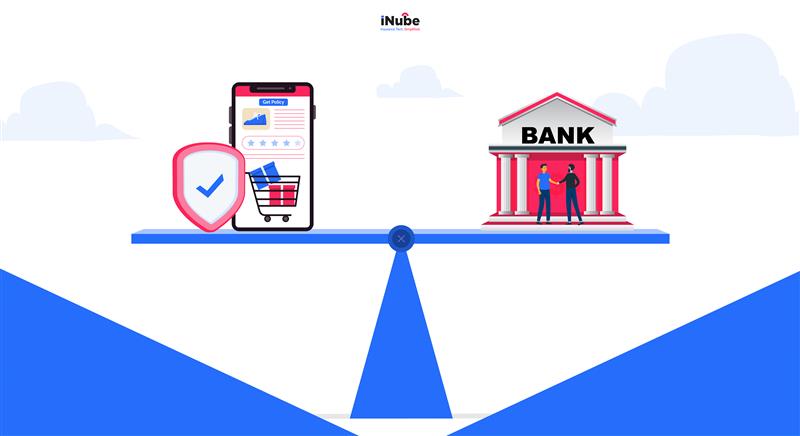The Indian insurance sector is truly standing at a crossroads in redefining insurance distribution. On one side lies bancassurance, which is the decades-old powerhouse of distribution with its reach rooted in banks backed by the trust of millions of Indians. On the other side stands the Direct-to-consumer or the D2C channel, which is digital-first, fast, and extremely focused on customer convenience.
The question is no longer whether both models could co-exist, because they already do. However, the real question lies- who will be leading India’s next insurance boom?
Bancassurance Still Matters- Why?
The Bancassurance channel has long been a silent growth engine for insurers in India. For instance, imagine walking into any of the branches of a leading bank; the probability of being offered a bundled Life, Health, or Accidental Insurance policy is quite high.
This is not just about convenience, it’s about trust. For most of the Indians, especially in the Tier 1 and Tier 3 cities, banks form the first option for everyone to access financial products, which becomes a solid foundation for enforcing trust and safety.
With its decade-old foundation of trust, the IMARC has given a vivid report on the valuation of the bancassurance market in India, which stands at USD 105.2 billion as of 2024. Not only that, it is also projected to grow at a CAGR of 6% over the next decade.
Not just that, the bancassurance models have been growing at a 19% CAGR between 2015 and 2022, which significantly highlights the model’s consistency.
However, the tension lies in whether to trust the anchors of bancassurance, as convenience is redefining the expectations.
Hop onto the next section to decode the answer to this.
The Digital Wave
Today, the demographics of policy buyers are changing, as Gen Z and millennials are making up 50% of the Indian demographics. In this scenario, buying an insurance policy through a branch feels quite an outdated option, especially when it comes to buying Health Insurance policies.
Today, customers are expecting instant quotes, paperless KYC, and the ability to compare as well as purchase with just a few taps on the phone. This is exactly where the D2C models thrive.
To support this, there are multiple digital insurance platforms that have shown that the customers are willing to bypass the insurance agents and the banks if the digital journey is smooth, transparent, and quick. One of the PwC studies noted that India’s penetration rate is still at 3.7 percent, which is far below the global average. The biggest opportunity that lies here in closing this gap is in digital-first distribution, which reduces the cost of acquisition and also improves accessibility.
The rise of the D2C sales channels is not just about technology but about reshaping trust. For the digital natives, trust essentially stems from the user reviews, transparent pricing, and seamless service rather than a banker’s approval.
Understanding the Battle- Trust Vs. Convenience
The D2C vs. Bancassurance debate is not just about which is better, but it’s more about which can align more closely with the changing definition of trust and convenience in India.
The trust factor plays an extremely important role in insurance distribution. The digitally savvy customers in the urban population no longer only trust face-to-face relationships; instead, trust is built through transparent pricing, clear policy comparisons, customer reviews, and seamless claims experiences.
In this world, convenience becomes a proxy for trust. However, if a D2C platform can offer a policy in minutes, with instant confirmation and a clear claims process, the customers will be more likely to trust it even if they have met an insurance agent or a broker.
Both the D2C channels and bancassurance distribution models have their benefits in shaping the new-age insurance distribution.
Why Bancassurance Channels Win on Trust?
Bancassurance channels have long been trusted by policyholders. Here are the top reasons why the bancassurance channels win on trust:
Banks are Most Trusted
One of the top reasons why the bancassurance channels win on trust is that they are deeply embedded in India’s financial culture. For most of the first-time policyholders in Tier 2 and Tier 3 cities, banks are the go-to option for getting insurance products.
Credibility
Credibility that comes with bancassurance is another one of the top reasons why bancassurance channels win on trust. Whenever a bank endorses an insurance product, it essentially inherits the credibility of the banking institution, which is a critical factor in the markets where people are skeptical of lesser-known insurance brands.
Why D2C Distribution Models Win on Convenience?
The D2C insurance models essentially win on convenience because:
Seamless Accessibility
The D2C insurance models allow the policyholders seamless accessibility to browse, compare, and purchase policies instantly without having to navigate through the paperwork or even waiting for the banker’s approval.
Transparent
One of the top reasons for the policyholders, especially the Gen Z and millennial population, to trust the D2C distribution models is that they are on-demand, transparent, and app-driven. The Morder Intelligence reports that the digital insurance platforms in India are expanding at a CAGR of 23%, which will be far from outpacing the traditional channels like the bancassurance channels.
Where Trust Meets Convenience
The actual question lies- Can trust keep pace with convenience?
If the bancassurance channels can digitize their processes and offer seamless, app-based experiences powered by bank credibility, then they could significantly retain their dominance.
On the other hand, if the D2C channels can significantly deepen their credibility, through strong claim settlement ratios, transparent communication, and customer education, the perception of trust away from the banks to digital-first insurers can significantly shift.
The battle is not just about who can sell policies; rather, it’s about how the Indian customers can significantly redefine the word ‘trust’ in the digital age.

Archismita Mukherjee
Insurance Content Analyst


